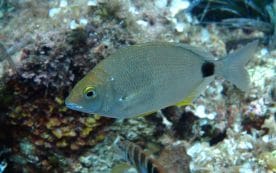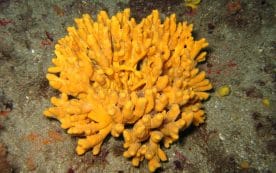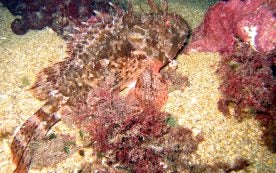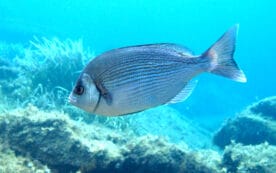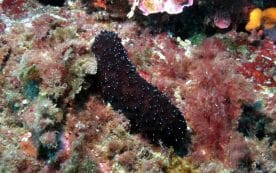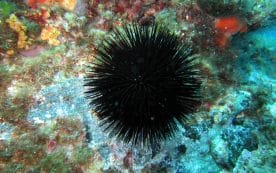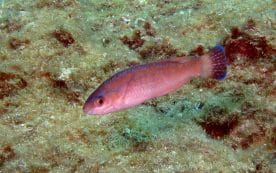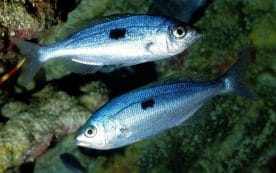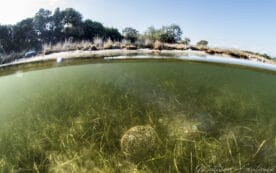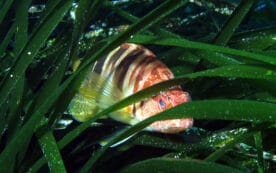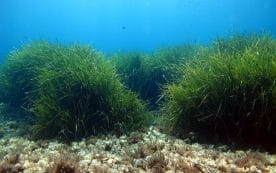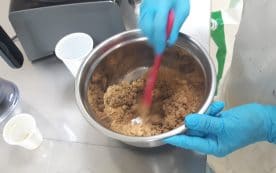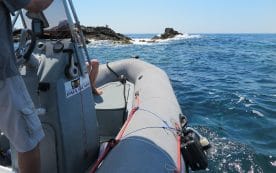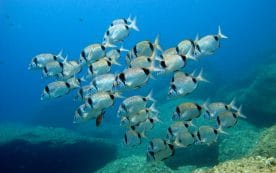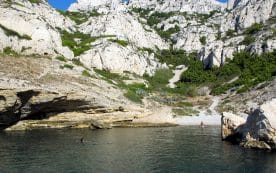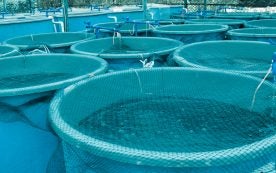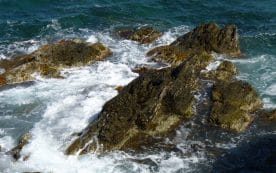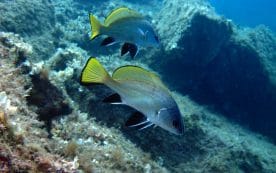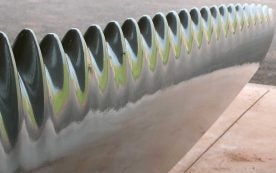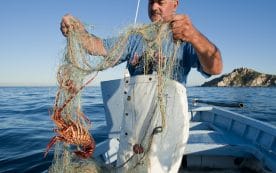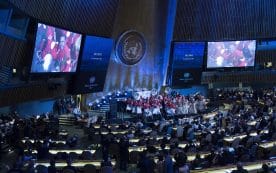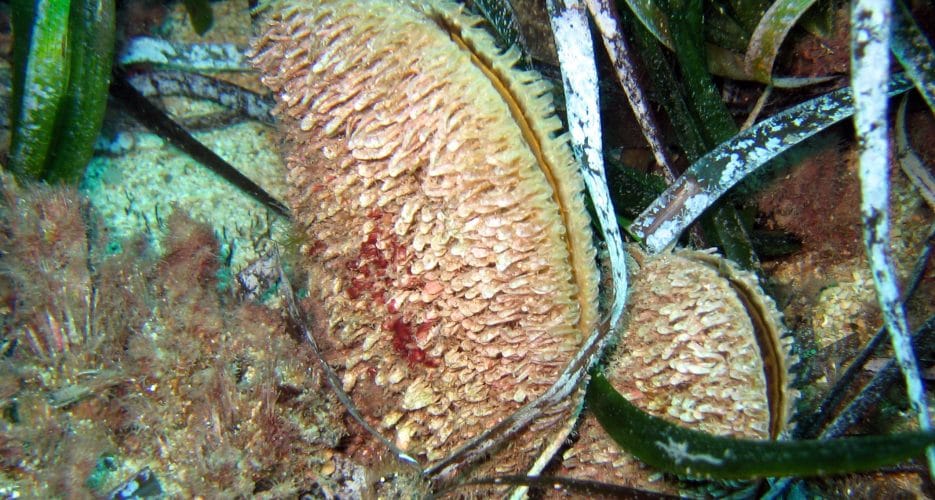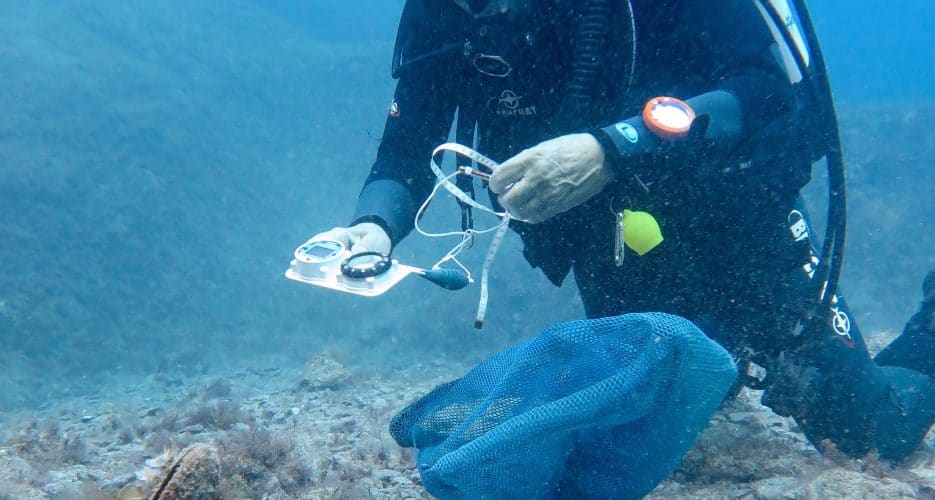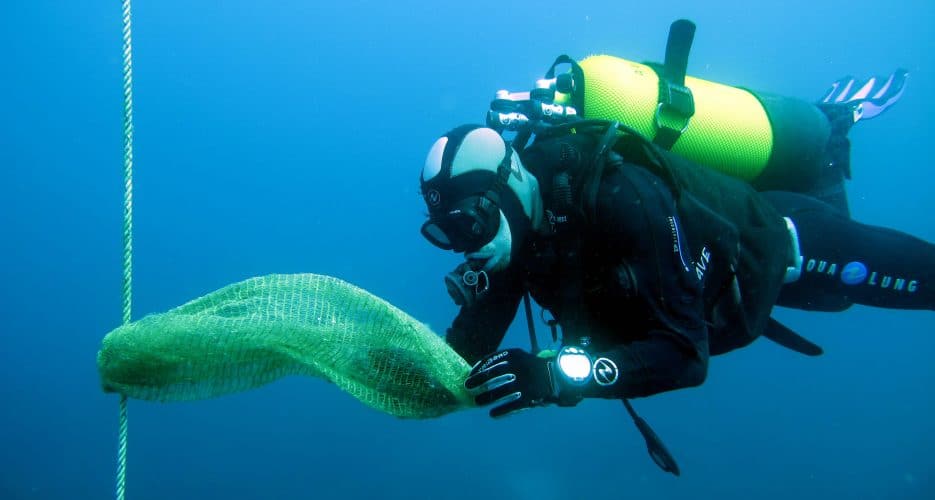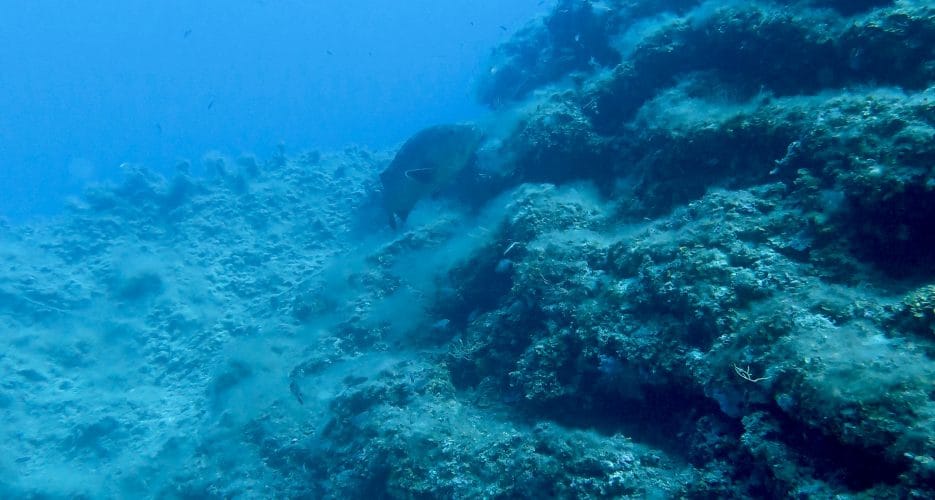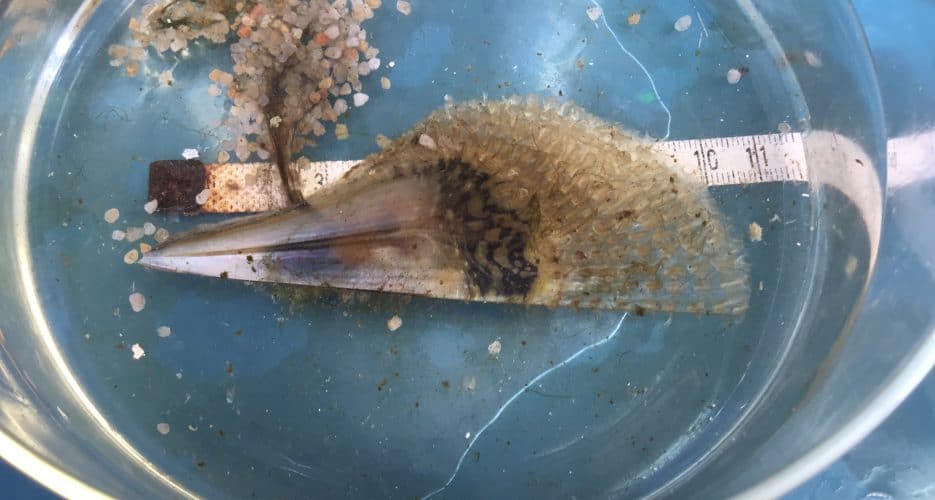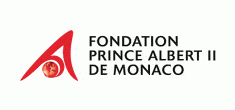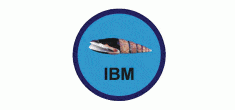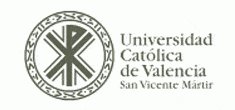Context
Pinna nobilis fan mussels have been protected in France since 1992. They are among the world’s largest shellfish and can grow to over one metre. This species is endemic to the Mediterranean. Their large size and long lifespan mean that they record shifts in the physical and chemical parameters of the marine environment, like sentinels along our coasts. Prof. Nardo Vicente and the team at the Institute are involved in various research programmes along coastlines in the Mediterranean basin.
Programme
Pinna SPOT is a joint programme with Monaco, Spain and Montenegro to inventory fan mussel populations and study their living conditions at selected sites and the genetics of different Mediterranean populations. The Pinna SPOT sites in France are located around Les Embiez island in the Var (South of France).
Another programme, targeting marine protected areas, covers the Scandola nature reserve in Corsica, the Port-Cros National Park (Var), the Côte Bleue marine reserve (Bouches-du-Rhône)* and the Larvotto marine reserve in the Principality of Monaco.
Phase 1
Long-term monitoring of populations in marine protected areas began 40 years ago and has now been extended to other study sites. Populations in all the protected areas have increased in recent years, but the fan mussel is now facing a new threat. The species is being decimated by a parasite, especially off the Spanish coast where mortality rates have been 100% in some places. The Mediterranean basin is now being monitored with an “environment watch” to report infected zones and monitor the spread of the disease, which seems to be accelerating.
Phase 2
Larvae capture is being used to analyse the recruitment of juveniles in various zones. The captured juveniles are then matured in captivity, where they are fed with phytoplankton. The aim is to conserve live individuals for physiological studies in a controlled environment (feeding, filtration, respiration, growth) and then eventually return them to coastal waters. Based on our current knowledge of the species’ biology, the captive individuals sometimes appear to be bigger than they would be in the wild at the same age. This depends on what they are fed and the physicochemical conditions in which they are kept.
Phase 3
This phase involves isolating the genome of Pinna nobilis and investigating whether any exchanges exist between populations in the Adriatic, the western and the eastern Mediterranean basins. Samples taken from the animals for genetic testing are kept to a minimum and do not disrupt their metabolism in any way. Samples from labs at the Paul Ricard Oceanographic Institute, IMEDMAR (Catholic University of Valencia) and IMBK (University of Montenegro) are currently being tested.
Last updated on : 25 March 2022
Partnerships
Administrative
– (*) Agence Française pour la Biodiversité (AFB): The AFB is a government agency created by the law on biodiversity of 8 August 2016. It replaced Onema (the national water and aquatic environments agency), the national parks agency, the marine protected areas agency and the ATEN public interest grouping.
– IUCN
– MEDPAN
Scientific
The research program has several European partners from the Mediterranean region:
– Catholic University of Valencia (Dr. Jose Rafael Garcia March, scientific director of IMEDMAR)
– IMBK (the Kotor Marine Biology Institute), Montenegro (Danijela Joksimovic, PhD)
– IMBE (Mediterranean Institute of marine and terrestrial Biodiversity and Ecology), (Prof. Thierry Tatoni)
– the EB2M team, Protée Laboratory (Toulon University)
– University of Nice, ECOMERS Laboratory (Prof. Patrice Francour)
Financial
– Prince Albert II of Monaco Foundation
– Port-Cros National Park
– Corsica regional park
– Agence de l’eau Rhône Méditerranée Corse
VICENTE, N., R. SIMIDE, S. TRIGOS, J.M COTTALORDA, J.M DOMINICI, 2018 – Poursuite de l’inventaire de Pinna nobilis et de Pinna rudis. Dynamique des populations. Nouveaux essais de captage larvaire dans la Réserve naturelle de Scandola.
Rapp.PNRC, N°17, 2015. 36 p.
ANDREE K.B., TRIGOS S., VICENTE N., CARRASCO N., CARELLA F., PRADO P. 2018 – Identification of potential recruitment bottlenecks in larval stages of the giant fan mussel Pinna nobilis using specific quantitative PCR. Hydrobiologia
TRIGOS, S.,VICENTE, N., PRADO,P , ESPINOS, F.J , 2018 – Adult spawning and early larval development of the endangered bivalve Pinna nobilis. Aquaculture 483 : 102-110
VICENTE, N., S.TRIGOS, D.KIRCHHOFER, 2017 – État des populations du Mollusque Bivalve Pinna nobilis, la Grande Nacre de Méditerranée sur les côtes de Provence de 2009 à 2016. Rapp. Agence de l’eau, Convention IOPR, n° 2015-1941, 62p.
VESNA MACIC, SEBASTIAN HERNANDIS CABALLERO, NARDO VICENTE, JOSE RAFAEL GARCIA MARCH, JOSE TENA MEDIALDEA, RAJKO MARTINOVIC, DANIJELA JOKSIMOVIC, DRAGANA DRAKULOVIC AND SLAVICA PETOVIC., 2017- Exceptionally high densitiy of Pinna nobilis L.1758, in the Boka Kororska Bay (Montenegro). 3d European Conference on Scientific Diving, Funchal, Madeira island-Portugal, 22-23 March 2017
TRIGOS S., N. VICENTE, 2016 – Transplantation protocol for the fan mussel Pinna nobilis in different types of substrate. Mar.Life-Vol.18: 55-61
VICENTE N., 2016 – La grande nacre de Méditerranée Pinna nobilis. In : Méditerranée- Mer Vivante, Nice-Doyen Ed., France, pp : 32-34
TRIGOS, S., VICENTE, N., KIRCHHOFER, D., GARCÍA-MARCH, J.R., TENA, J., TORRES, J. 2015a – Current status of Pinna nobilis in “Le Brusc” lagoon.(Site Natura 2000). Colloque DRIVER -SUBLIMO life+. Restauration des nurseries des petits fonds côtiers de Méditerranée. Ile des Embiez (VAR, France) 22 Juin 2015.
TRIGOS, S., VICENTE, N., KIRCHHOFER, D., MIARD, T., GARCIA-MARCH, J.R., TORRES, J., TENA, J. 2015b – Growth rates of Pinna nobilis in controlled conditions during first months of live. Colloque DRIVER -SUBLIMO life+. Restauration des nurseries des petits fonds côtiers de Méditerranée. Ile des Embiez (VAR, France) 22 Juin 2015.
ROUANET, E., S.TRIGOS, N.VICENTE, 2015 – From youth to death of old age : the 50-year story of a Pinna nobilis fan mussel population at Port-Cros Island (Port-Cros National Park, Provence, Mediterranean Sea) Sci.Rep.Port-Cros natl.Park,29 : 209-222
BASSO, L., M.VAZQUEZ-LUIS, J.R. GARCIA-MARCH, S. DEUDERO, E. ALVAREZ, N.VICENTE, C.M. DUARTE, E. HENDRIKS, 2015 – The Pen Shell, Pinna nobilis : A Review of population Status and Recommended Priorities in the Mediterranean Sea. In : Barbara E.Curry, editor, Advances in Marine Biology, Vol.71, Oxford : Academic Press, 2015, pp. 109-160.
TRIGOS, S., N.VICENTE, J.R.GARCIA-MARCH, J.TORRES, and J.TENA, 2015 – Embryological Development of Pinna nobilis in Controlled Conditions. In : Marine Productivity : Perturbations and Resilience of Socio-ecosystems.H-J. Ceccaldi and al. (eds.). Springer International Publishing Switzerland 2015, pp. 369-371.
TRIGOS SANTOS, S., J.R GARCIA-MARCH, N.VICENTE, J. TORRES GAVILA, y J.TENA MEDIALDEA, 2015 – Phytoplankton Profitability and Use as Organic Matter Source by Pinna nobilis. Nereis 7 : 77-82
TRIGOS, S., J.R GARCIA-MARCH, N.VICENTE, J. TENA, J.TORRES, 2014 – Respiration rates of the fan mussel Pinna nobilis at different temperatures Journal of Molluscan Studies 1-6.
TRIGOS, S., J.R. GARCÍA-MARCH, N. VICENTE, J. TENA, J. TORRES, 2014 – Utilization of muddy detritus as organic matter source by the fan mussel Pinna nobilis. Mediterranean Marine Science, 15(3), 667-674.
MARTÍNEZ, A., TRIGOS, S., GARCÍA-MARCH, J.R., VICENTE, N., TORRES, J., DEUDERO, S., VÁZQUEZ-LUIS, M., DEL TORO, M.J., TENA, J. 2014 – Comparative study of growth of the endangered bivalve Pinna nobilis in marine protected areas vs. unprotected areas of the western Mediterranean Sea. XVIII Simposio Ibérico de Estudios de Biología Marina, 2 al 5 de Septiembre de 2014.
HARMELIN J.G., J. VACELET, N. VICENTE, 2013 – Premières évaluations du patrimoine sous- marin du Parc national de Port Cros (France, Méditerranée) : les campagnes Poséidon. Sci.Repts Port-Cros natl Park, 27 : 119-128.
TRIGOS SANTOS S.,N. VICENTE, J.R. GARCIA-MARCH, S. JIMÉNEZ, J. TENA, J. TORRES,2013 – Presence of Pinna nobilis and Pinna rudis in the Marine Protected Areas of the North Western Mediterranean. 3rd International Marine Protected Areas Congress 21-27 October2013, Marseille & Corsica, France.
TRIGOS SANTOS S., N. VICENTE, J.R. GARCIA-MARCH, J. TORRES, J. TENA, 2013 – Firstdata on the artificial rearing of the larvae of Pinna nobilis. 3rd International Marine Protected Areas Congress 21-27 October 2013, Marseille & Corsica, France.
TRIGOS SANTOS S., N. VICENTE, J.R. GARCIA-MARCH, J. TORRES, J. TENA, 2013 – First data on the Embryological development of Pinna nobilis in controlled conditions. 15ème Colloque franco-japonais d’océanographie. 21-22 Octobre 2013, Marseille, France.
GARCÍA-MARCH J.R., N. VICENTE, 2006 – Protocole d’étude et de surveillance des populations de Pinna nobilis dans les aires marines protégées. Outil de Gestion MedPAN / MEPA, 79 pp. www.medpan.org/_upload/996.pdf
VICENTE N., 2005 – Une forêt sous la mer. In : 100 belles plongées à Marseille et dans sa région. Ed. GAP, France, pp : 276-295.
GAULEJAC de B., E. MEDIONI, N. VICENTE, 2003 – Essais de captage de Pinna nobilis et autres mollusques sur les côtes méditerranéennes françaises. In : Premier Séminaire International sur la Grande Nacre de Méditerranée : Pinna nobilis. 10-12 octobre 2002, à Ile des Embiez, France, Mém. Institut océanogr. Paul Ricard, pp : 57-62.
MEDIONI E., N. VICENTE, 2003 – Étude de la cinétique des populations de Pinna nobilis (L.) 1758, sur le littoral méditerranéen français. In : Premier Séminaire International sur la Grande Nacre de Méditerranée : Pinna nobilis. 10-12 octobre 2002, à Ile des Embiez, France, Mém. Institut océanogr. Paul Ricard, pp : 43-48.
VICENTE N.,2003 – La grande nacre de Méditerranée Pinna nobilis. Présentation générale. In : Premier Séminaire International sur la Grande Nacre de Méditerranée : Pinna nobilis. 10- 12 octobre 2002, à Ile des Embiez, France, Mém. Institut océanogr. Paul Ricard, pp : 7-16.
VICENTE N., B.de GAULEJAC,M.AVON,2003 – Pinna nobilis indicateur biologique de la qualité du littoral méditerranéen. In : Premier Séminaire International sur la Grande Nacre de Méditerranée : Pinna nobilis. 10-12 octobre 2002, à Ile des Embiez, France, Mém. Institut océanogr. Paul Ricard, pp : 111-116.
MATHEW J., J. PETERSON, B. de GAULEJAC, N. VICENTE, M. DENIS, J.BONAVENTURA, L.L. PEARCE,1996 – Manganese and «Pinnaglobin» in Pinna nobilis. Comp. Biochem. Physiol., 113 (3) : 525-532.
GAULEJAC de B., M. HENRY, N. VICENTE, 1995 – An ultrastructural study of gametogenesis of the marine bivalve Pinna nobilis (L) 1758. I – Oogenesis. J. Molluscan Stud., 61 : 375-392.
GAULEJAC de B., M. HENRY, N. VICENTE, 1995 – An ultrastructural study of gametogenesis of the marine bivalve Pinna nobilis (Linnaeus 1758). II – Spermatogenesis.J. Molluscan Stud., 61 : 393-403.
BUTLER A., N. VICENTE, B. de GAULEJAC, 1993 – Ecology of the pterioid bivalves Pinna bicolor Gmelin and Pinna nobilis L. Mar. Life, 3 (1-2) : 37-45.
HENRY M., N. VICENTE, N. HOUACHE, 1992 – Caractérisation des hémocytes d’un mollusque bivalve marin, la nacre Pinna nobilis L. 1758. In : Aspects récents de la biologie des mollusques. IFREMER. Actes de coll.,13 : 97-106.
VICENTE N., B. de GAULEJAC, A. RIVA, 1992 – Ecological study and preservation of the bivalve mollusc Pinna nobilis L. 1758, in the Mediterranean sea. Mesogée, 52 : 100.
VICENTE N., A. RIVA, A. BUTLER, 1992 – Étude expérimentale préliminaire sur les échanges gazeux chez Pinna nobilis (L.) 1758. In : Aspects récents de la biologie des mollusques. IFREMER. Actes de coll.,13 : 187-189.
VICENTE N., 1991 – Estudio ecológico y protección del molusco lamelibranquio Pinna nobilis L., 1758 en la costa mediterránea. Iberus, 9 (1-2) : 269-279.
VICENTE N., MORETEAU J.C., 1991 – Statut de Pinna nobilis L. en Méditerranée (Mollusque eulamellibranche). In : Les espèces marines à protéger en Méditerranée. C.F. BOUDOURESQUE, M. AVON, V. GRAVEZ (eds), GIS Posidonie Publ., Marseille, pp : 159-168.
BAGHDIGUIAN S., N. VICENTE, M. HENRY, 1990 – Aspects cytologiques particuliers et présence de lamelles annelées dans les cellules somatiques et germinales des mollusques bivalves. Haliotis, 20 : 163-177.
VICENTE (N.)., 1990- Grande nacre : Un réseau méditerranéen de protection. Océanorama, Institut océanographique Paul Ricard, 15, p.31-34.
GAULEJAC de B., N. VICENTE, 1990 – Écologie de Pinna nobilis (L.) mollusque bivalve sur les côtes de Corse. Essais de transplantation et expériences en milieu contrôlé. Haliotis, 20 : 83-100.
VICENTE N., 1990 – La protection des espèces dans les parcs et réserves marines en Méditerranée. Les invertébrés. In : Parchi marini del Mediterraneo : aspetti naturalistici e gestionali. A. COSSU, V. GAZALE, I. MILELLA (eds), atti del 1° convegno internazionale,
MORETEAU J.C., N. VICENTE, 1988 – Étude morphologique et croissance de Pinna nobilis L. (mollusque eu-lamellibranche) dans le Parc national de Port-Cros (Var- France). Rapp. P.-v. Réun. CIESM, 31 (2) : 20.
BAGHDIGUIAN S., P. ESCOUBET, J.L. d’HONDT, F. LABOREL-DEGUEN, A. RIVA, VICENTE N., 1987 – Les Invertébrés. In : Livre rouge des espèces menacées en France. Tome 2 : Espèces marines et littorales menacées. F. de BEAUFORT, J.C. LACAZE (eds), MNHN publ., Paris, pp : 207-237.
VICENTE (N.), 1986- La grande Nacre de Méditerranée. Parc national de Port-Cros, [plaquette de présentation], 4 volets.
VICENTE (N.) 1984- Grand coquillage plein de distinction. La grande nacre de Méditerranée Pinna nobilis. Revue de la fondation océanographique Ricard, 7, p.30-34.
VICENTE (N.), MORETEAU (J.-C.), ESCOUBET (P.),1980- Etude de l’évolution d’une population de Pinna nobilis L. (Mollusque Eulamellibranche) au large de l’anse de La Palud (Parc National sous-marin de Port-Cros), Trav. Sci. , Parc natl. de Port-Cros, 6, p.39- 68.

